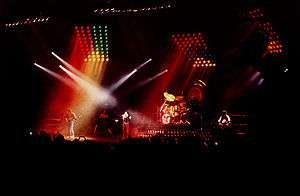Arena rock

Arena rock (also referred to as pomp rock,[1] stadium rock,[2] anthem rock,[3] or corporate rock[4]) is a style of rock music that originated in the mid 1970s. As hard rock and heavy metal bands became increasingly popular, arena rock developed from their use of more commercially oriented and radio-friendly sounds, with highly produced music that includes both rockers and power ballads, both often employing anthemic choruses.[5]
History
In the mid-1970s, increased power of amplification and sound systems allowed the use of larger and larger venues.[2] Smoke, fireworks and sophisticated lighting shows became staples of arena rock performances.[6] It has been argued that the rise of arena rock marked the end of the idealism of the 1960s, particularly in the disillusionment that followed the Altamont Free Concert of 1969, for a more commercial form of rock.[2] Key acts included Journey,[5] REO Speedwagon,[5] Foreigner,[5] Styx,[5] Kiss,[7] Peter Frampton,[7] Boston[5] and Queen.[8][9] Bands outside hard rock also achieved arena status after taking a more commercial direction. Genesis developed from a cult progressive rock band into one of the biggest stadium bands in the world after Phil Collins became lead singer in 1975,[10] and Supertramp also went from progressive rock to filling arenas around the world when their style of music was supposed to have gone out of fashion.[11]
The use of commercial sponsorship for the large-scale tours and concerts of this era began to lead to the music being branded, usually pejoratively, as corporate rock.[12] The commercialism, and "overblown" spectacle of stadium rock has been seen as promoting a number of reactions, including the pub rock[13] and punk rock movements in the 1970s.[14] In the 1980s, arena rock became dominated by glam metal bands, following the lead of Aerosmith[15] and including Mötley Crüe, Quiet Riot, W.A.S.P. and Ratt. Their popularity was challenged by the alternative rock bands who began to breakthrough to the mainstream, particularly after the success of Nirvana, from the early 1990s.[16]
See also
Notes
- ↑ Crystal, David (2014). Words in Time and Place: Exploring Language Through the Historical Thesaurus of the Oxford English Dictionary. Oxford University Press. p. 220. ISBN 0-19-968047-7.
- 1 2 3 Waksman 2009, pp. 21–31.
- ↑ Donaldson, Gary A. (2009). The Making of Modern America: the Nation from 1945 to the Present. Rowman & Littlefield. p. 248. ISBN 0-7425-4820-1.
- ↑ Smith, Chris (2006). The Greenwood Encyclopedia of Rock History: From Arenas to the Underground, 1974–1980. Greenwood Press. p. 74. ISBN 0-313-32937-0.
- 1 2 3 4 5 6 AllMusic.
- ↑ Shuker, Roy (2002). Popular Music: the Key Concepts (2nd ed.). London: Routledge. p. 158. ISBN 0-415-28425-2.
- 1 2 Shepherd 2003, p. 423.
- ↑ Buckley, Peter (2003). The Rough Guide to Rock (3rd ed.). Rough Guides. p. 835. ISBN 1-84353-105-4.
- ↑ Thrills, Adrian (11 March 2011). "We STILL rock you: Re-releases chart Queen's rise to power". Daily Mail. Retrieved 16 June 2011.
- ↑ McLean, Craig (30 September 2014). "Genesis interview: 'We were hated'". The Daily Telegraph. Retrieved 18 August 2015.
- ↑ Deming, Mark. "Supertramp – Artist Biography". AllMusic. All Media Network. Retrieved 18 August 2015.
- ↑ Reynolds, William M; Webber, Julie A (2004). Expanding Curriculum Theory: Dis/positions and Lines of Flight. London: Routledge. p. 24. ISBN 0-8058-4664-6.
- ↑ Bennett, Andy (2006). "Even better than the real thing? Understanding the tribute band phenomenon". In Homan, Shane. Access All Eras: Tribute Bands and Global Pop Culture. Hill International. p. 26. ISBN 0-335-21690-0.
- ↑ Browne, Pat; Browne, Ray B. (2001). The Guide to United States Popular Culture. Popular Press. p. 31. ISBN 0-87972-821-3.
- ↑ Joyner, David Lee (2008). American Popular Music (3rd ed.). McGraw-Hill Education. p. 261. ISBN 0-07-352657-6.
- ↑ "Pop/Rock » Heavy Metal » Hair Metal". AllMusic. All Media Network. Retrieved 6 July 2010.
Sources
- "Pop/Rock » Hard Rock » Arena Rock". AllMusic. All Media Network. Retrieved 20 January 2011.
- Shepherd, John, ed. (2003). Continuum Encyclopedia of Popular Music of the World. 1. Continuum. ISBN 0-8264-6321-5.
- Waksman, Steve (2009). This Ain't the Summer of Love: Conflict and Crossover in Heavy Metal and Punk. University of California Press. ISBN 0-520-25310-8.